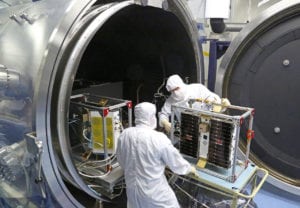NASA Reschedules CYGNSS Air-Launch

Southwest Research Institute engineers prepare four of the eight CYGNSS microsatellites for thermal vacuum testing. Photo: Southwest Research Institute
[Via Satellite 12-13-2016] NASA has rescheduled the launch of its Cyclone Global Navigation Satellite System (CYGNSS) spacecraft for no earlier than Wednesday, Dec. 14, from Cape Canaveral Air Force Station in Florida, during a one-hour window that opens at 8:20 a.m. EST, the agency announced on Dec. 12, the original launch date. Monday’s launch was aborted due to an issue with Orbital ATK’s launch vehicle release system on the L-1011 Stargazer aircraft. A hydraulic system operates the mechanism that releases the Pegasus rocket from the carrier aircraft.
The current targeted Wednesday launch time will allow for a replacement L-1011 carrier aircraft component to arrive from Mojave, California, and be installed, as well as support the required crew rest requirements.
The CYGNSS constellation consists of eight microsatellites designed and built for NASA at Southwest Research Institute (SwRI). The spacecraft were designed to “see” through thick clouds and heavy rains to measure the movement of ocean waves beneath hurricanes. The mission’s goal is to accurately measure wind speeds and hurricane intensification for the first time.
After launch, the eight microsatellites — each roughly the size of a carry-on suitcase when the solar arrays are stowed — will be oriented in a pattern that allows successive satellites to pass over the same region every 12 minutes, with a median revisit time of less than three hours. Once positioned, the satellites will operate with minimal course adjustments throughout the two-year primary mission.
The microsatellites are expected to deploy and begin testing and operations within the first 24 hours. Full hurricane science operations will begin in January — well in advance of the 2017 hurricane season.
Images: http://www.swri.org/press/2016/swri-built-hurricane-satellites-cygnss.htm